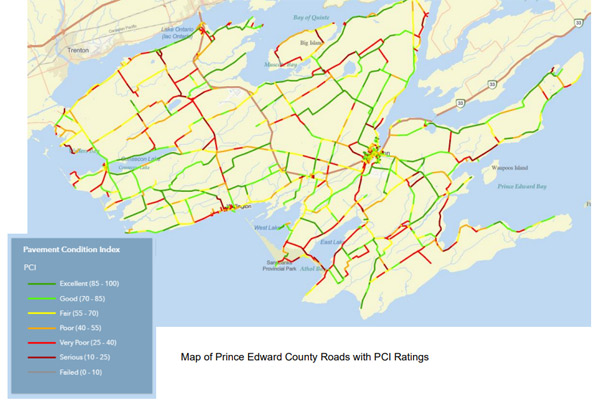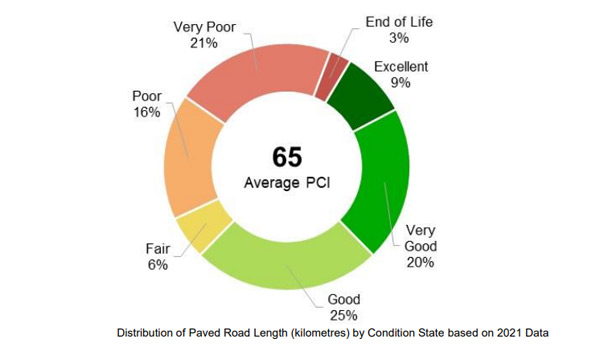Discussions begin on managing County assets – starting with roads
Administrator | Apr 26, 2025 | Comments 4
By Sharon Harrison
Working sessions with council and staff have begun a process of in-depth discussions on the extensive topic of how the municipality’s assets (roads, bridges, buildings, equipment, facilities, vehicle fleets -including fire department, and parks and recreation facilities) are managed.
Essentially, an Asset Management Plan (AMP) allows the municipality to plan for the infrastructure needed today, incorporating the costs to manage and operate those assets and have the funds to replace it when it reaches the end of its useful life.
The province demands all municipalities update and expand their AMP, with a deadline of July 1. It involves identifying resources and activities needed for maintaining, updating or replacing the County’s infrastructure. It includes working toward an AMP that includes proposed levels of service (LOS) and a sustainable long-term financial strategy to achieve those levels.
In the first of three planned council-staff sessions over the next few months, Thursday’s two-and-a-half hour discussion featured a general introduction, where the discussion then focused on roads, and the PCI (pavement condition index).
As it was not a formal meeting of council, the session kept procedural formalities to a minimum, where they even moved to a first-name basis, had open dialogue and thoughtful feedback encouraged by council and staff.
“The intention is to have an open, in-depth discussion between council and staff to ensure that members of council have a full understanding of the issues, and staff have the benefit of hearing council’s concerns in respect to this,” said mayor Steve Ferguson.
He outlined how the format model being adopted has been used elsewhere, particularly in Vaughan, which was the first municipality to undertake this kind of informal council – staff working session, initiated by the County’s current clerk, Victoria Leskie and the CAO there at the time; then migrated to another city, and now eastward here.
He said the new format, a first for the County, was a new model designed to aid council in the decision-making process to commence consideration of a major and multi-faceted issue, and they hope to use the model for other complex issues.
The second such working session to take place on May 15 is to focus on bridges, but also cover facilities/buildings and equipment (for example, IT, server data centres, jaws of life for the fire department, etc.). The municipality has 25 bridges, 24 structural culverts, and 14 park/trail bridges, and owns and manages 94 facilities that support services
The June 12 session is to include fire fleet and corporate fleet, and parks and recreation. The municipality has eight accredited fire stations and 33 fleet assets, owns and maintains 113 parks and recreation assets (for example, ball diamonds, playground equipment, etc.), and owns and manages 114 fleet assets.
Councillors are to consider the preferred levels of service and associated financing strategy for the asset management plan at the Aug. 28 committee of the whole meeting and the public is invited to participate. It will see all combined asset classes discussed together, along with costs associated with the different service levels, as well as the cost to ratepayers.
The AMP should be finalized in September, and is to be updated annually. The province requires every municipality, by July 1, 2025, to have plans which include specific elements like service levels, lifecycle management strategies, financial plans, and funding sources.
While the public was invited to follow along in-person at Shire Hall or watch the live-stream (or the recording after) for observation only, there is no public participation (deputations or comments) at this stage, either in this working session, or for the next two sessions. The public may provide comment at the August meeting.
In the meantime, the public can join the conversation or provide input via the County’s Have Your Say website which contains information and the discussion papers and will be updated for each meeting. Further, pop-up event opportunities are to be scheduled over the summer, along with a public survey.
“Within that, we are going to be asking the public their satisfaction of municipal services and assets, suggestions for services and asset improvements, asset expectations and what are their expectations for the levels of municipal service,” outlined Emily Cowan, director of community services, programs and initiatives. The survey will also ask the public of their willingness to pay to maintain the levels of service, or to increase the levels of service and service priorities for funding allocations.
Arryn McNichol, acting director of finance and information technology, provided a presentation outlining generally the asset management plan and the level of service framework, where he indicated how the process will aid in the 2025 asset management plan.
He explained what an asset is, what asset management planning is, what the planning process is, and went over the asset classes.
Assets, he said, are everything the County owns, such as roads and bridges, vehicles, parks, buildings and equipment. He explained that these assets provide a service, and the better condition the assets are in, the better the service that can be provided.
There are 10 different asset classes – the core assets being water and wastewater, storm sewer, bridges and roads. There are also non-core assets, such as facilities, fleet, roads-related, equipment, information technology, parks and recreation, and street lights.
“An assessment management plan is made up of four different components: the first component is the state of the infrastructure, which is what do we have, what is its replacement cost, what are we going to do with that particular asset, among other things. It’s like an inventory of assets for the municipality,” explained McNichol.
The second major section of the AMP is a life-cycle management strategy.
“Basically, this is how are we going to maintain these assets in order to get the most useful life out of them at the lowest possible cost: what are we going to renew, how are we going to maintain, and how are we going to replace the different items.”
The next major section is the levels of service (discussed at this meeting) where McNichol said each different asset provides a different level of service.
The final section is the financial strategy: how are we going to pay for these assets?
“That will be focused, not just on development charges, but also reserves, an increase in taxes, it could be an increase in user fees.”
The next step in the process is the level of service conversation, which McNichol said is defined as the quality and extent of services the municipality provides, such as safety, customer satisfaction, quality, reliability and cost.
ASSET MANAGEMENT CLASS – ROADS
McNichol explained the discussion paper, saying how the working session is an opportunity for council to openly talk about the risk, the cost and what level of service makes sense for the municipality.
“The report identifies the number of roads, it identifies the different PCI (pavement condition index) that we’re currently at under the StreetScan and what we are estimated to be at right now. It identifies the different types of roads,” said McNichol. “And it talks about some of the risks associated with some of claims we have coming on a regular basis related to bent rims, popped tires, and so forth.”
The discussion paper on roads (available on the County’s website) forms the basis of the conversation, and outlines the process for establishing an appropriate level of service.
The purpose of the series of discussions will allow council to ultimately to select a preferred level of service (which is the PCI for roads) each with associated annual costs and implications for quality, safety and financial sustainability.
“The selected level of service will serve as the target for the next 10 years, guiding maintenance and investment decisions.”
This upcoming AMP will detail the proposed levels of service for each asset category over a 10-year period, providing a roadmap for maintenance, renewal, and replacement activities, explained McNichol. The plan will also outline the associated costs and funding strategies to achieve these service levels.
The municipality owns and maintains 1,047 kilometres of public roads (both urban and rural roads), where the PCI ranges from poor to fair, with the overall rating considered fair.
Of the 1,047 kilometres of roads in the County, 342 kilometres are asphalt or HCB (high-class bituminous) material, and 523 kilometres are surface treatment, or LCB (low-class bituminous) material, with 90 per cent considered to be within a rural environment.
To determine the state of the County’s roads, the Ministry of Transportation Ontario uses the PCI rating system for all roadways across the province. It consists of two components, namely RCR (ride comfort rating) which measures the smoothness and comfort of the ride, and DMI (distress manifestation index), a visual inspection that evaluates the road’s physical condition and visible damage.
The PCI has a rating system of 0-100 that helps authorities assess the overall quality of a pavement section, guiding decisions on maintenance and rehabilitation priorities. The 2022 AMP highlights the PCI values derived from the 2021 StreetScan assessment for each road type in the County:
HCB (asphalt) = 69.7 –considered fair
LCB (surface treated) = 61.5 –considered fair
Concrete = 21.6 –considered poor
Gravel = 53 –considered poor
Overall PCI is 62.2 –considered fair.
“Through StreetScan it was found that, on average, HCB and LCB roads are in the fair condition state, concrete roads are in the very poor condition state, and gravel roads are in the poor condition state.”
Over the past five years, the municipality has successfully completed several major urban road rehabilitation projects, to include Picton Main Street, Talbot Street, Cold Storage Road, Elm Street, York Street and Bloomfield Main Street, totalling around $23.6 million.
“These initiatives were made possible through a strategic blend of funding sources, including the Canada Community-Building Fund, development charges, and the Ontario Community Infrastructure Fund.
From 2023 to 2025, the municipality has also made significant investments in rural road infrastructure covering around 305 kilometres of roads, totalling approximately $10.9 million.
The County’s roads are split up into four categories and there is a different PCI for each type of road: gravel (unpaved); concrete; surface treated roads (low-class bituminous roads); and asphalt roads (high-class bituminous roads).
It was noted how road maintenance deficiencies continue to place considerable strain on municipal resources, with aging infrastructure and recurring surface deterioration require frequent, reactive interventions.
“This reactive approach consumes valuable time and limits the capacity to undertake planned or preventative maintenance. The resulting pressure on operational budgets and staff capacity underscores the need for strategic investment in long-term asset management to improve road conditions, enhance public safety, and reduce overall lifecycle costs.”
Many roads that were originally constructed as single-surface treatments (maintenance) have deteriorated to the point where double-surface (rehabilitation) treatment is now required to restore them to a maintainable standard. This escalation in required repairs demonstrates how under investment compounds over time.
“With an extensive road network and limited resources, the County faces an unsustainable backlog, one that the municipality cannot realistically overcome without either significantly increasing funding for road rehabilitation or accepting a reduction in overall service levels.”
OPTIONS FOR TAX INCREASES
Assuming the current level of service is deemed insufficient to meet expectations, two service level options are suggested with each option indicating a different overall PCI, as well as the average surface treated (low-class bituminous) and asphalt (high-class bituminous) PCI, as follows:
Option 1 – Targeting an average PCI of 83 (considered excellent) for all roads, with an associated cost of $25.1 million annually, as the target service level for the next 10 years (2025-2035) – this option ensures that all surface-treated, and asphalt roads meet a minimum standard, thereby preserving consistent road quality and performance across the network;
or
Option 2 – Targeting an average PCI of 68 (considered fair), with an associated cost of $20.6 million annually, as the target service level for the next 10 years (2025-2035) and incorporate this service level in the public consultation on the proposed AMP prior to returning to council.
(Note, both options are not indexed for inflation over the 10-year period).
Under option 1, taxes would increase by 3.81 per cent, year-after-year for 10 years to completely close the infrastructure deficit, confirmed McNichol. Option 2 would see taxes increase by 3.06 percent, year-after-year for 10 years. (Updated finalized figures are to be available at the August meeting, and will provide a more accurate picture).
Councillor Roy Pennell was concerned about the interest accrued on the County’s debt.
“We’ve got the McFarland house that we got to borrow money for that, it is approximately $38 million in debt right now for the County, then we are looking at water,” said Pennell. “Just the interest on the money if those were the only projects ever carried out in the County in the next 10 years, $11 million a year in interest alone, and that figured into taxes is a ton of money.”
McNichol confirmed that any debt the County takes on would have both an interest and principal payment that would have to end up in the budget.
Councillor John Hirsch reminded that it costs $20 million just to keep the roads the way they are now.
“We aren’t investing enough now, we are still going to have to a three per cent annual increase for 10 years just to be at 68 [PCI], which makes 83 [PCI] sound more attractive to me because it’s not that much more money to actually achieve a much better overall level, and a lot fewer complaints,” said Hirsch.
A key point of the AMP is that it allows the municipality to do the right intervention, at the right time, to extend the life of the road, said Dave MacPherson, manager of engineering.
“It’s a balance of repairing the bad, but keeping the good roads good, and that is the balancing the Brightly Predictor [a decision-support software the municipality uses] does, and these are the best interventions for your buck.”
Councillor Corey Engelsdorfer said he was worried about the 3.8 per cent number being used out of context during the public engagement sessions.
“Ultimately the message is, if we want to fix them [the roads] we have to raise taxes 38 per cent [over 10 years], so I don’t want to be caught in that,” said Engelsdorfer. “If we show that 3.8 percent number and everybody says, why are roads so bad, why haven’t we been doing anything, the messaging needs to be, it’s a lot bigger problem than 3.8 per cent.”
Speaking to the total impact and contrasting scenarios over a 10-year period, councillor Kate MacNaughton said they should also be talking about the impact of what a zero increase looks like.
“I’m not advocating for that, I want to be very clear, but what that does like look because right now there is a conversation in the community that there should be a zero increase approach, which puts infrastructure at risk and has additional costs later,” expressed MacNaughton. “The do-nothing scenario, do no increase, and the dangers and cost.”
Over the past five years (2021-2025), the County has invested approximately $28.3 million in total in urban and rural roads. The proposed options seek to enhance the level of service by improving the PCI, with recommended increased investments to $20–$25 million annually, depending on the option chosen.
“This not only represents a significant increased pressure to finance such a plan over the next 10 years, but also will strain the County’s capacity, both in terms of staffing and equipment, to sustain these elevated levels of services under either proposed option.”
Below is the council-approved tax supported capital budgets for roads for the last three years. Note the 2025 budget includes $24 million in federal funding that has yet to be received for County Road 49.
2023 budget $10,720,971
2024 budget $14,753,900
2025 budget $55,875,065
Documentation and discussion papers for each asset class are available on the County’s website.
Filed Under: Featured Articles • Local News
About the Author:




































It seems the County’s attempt at slowing traffic by allowing roads to deteriorate to endless speed bumps has not worked. However it’s nice to hear the County is at least talking about road maintenance, roads have been neglected for decades. Lets hope they can worked together to accomplish the objectives they have identified… (Some of my comments are intended to be humorous and hopefully lighten the conversation)
Excellent point Gary. I agree.
We need to slow down the locals. Speed isn’t a tourist issue.
I am in favour of turning all roads back into dirt roads. That will slow the tourists down.